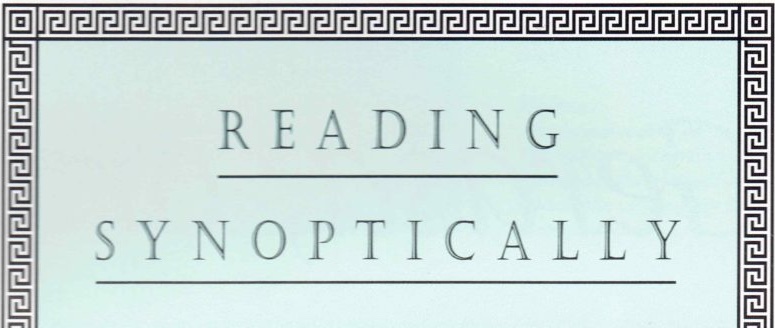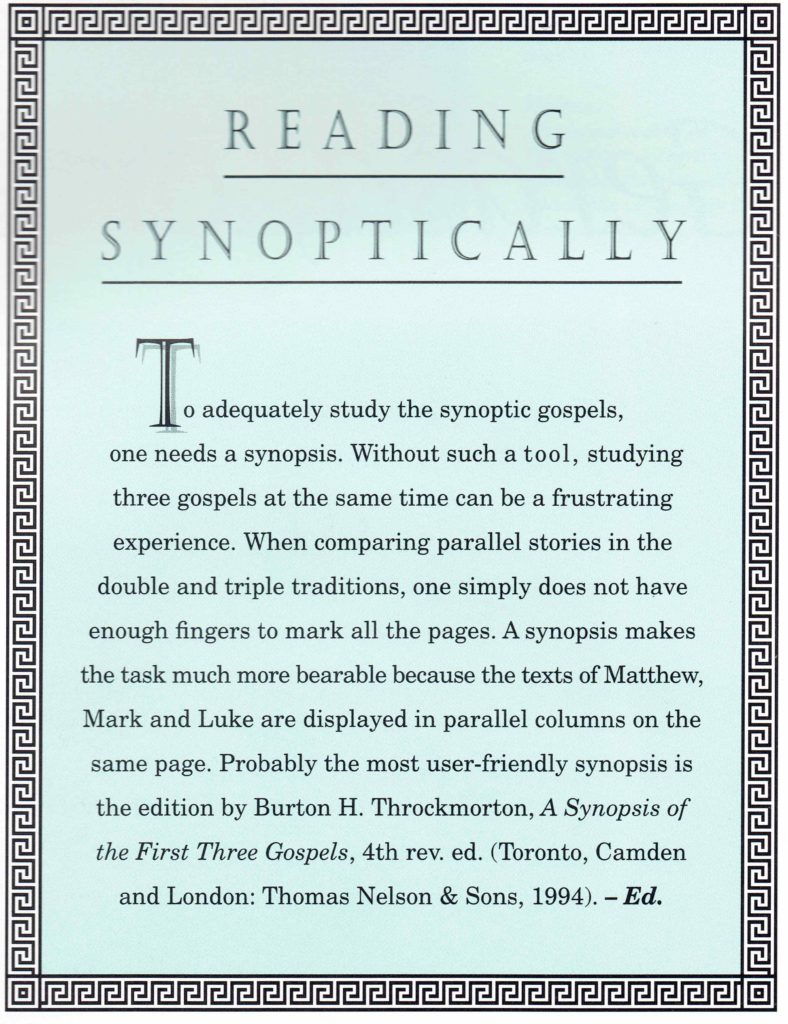If you are a serious student who wishes to engage in careful, analytical study of the Gospels, you’ll need a few special tools in your study tool box. Obviously, tool number one is a Bible translation that you can readily understand and one that gives a reasonably literal rendering of the Greek texts of the New Testament. Having several translations handy as you study is even more helpful. A concordance and a good Greek lexicon are indispensable, too.
But, if there is one tool that facilitates Gospel studies more than any other study aid, it is a “Synopsis” of the Gospels. “Synopsis” is a word that was derived from two Greek words: opsis (seeing), and syn (together), to express the concept of “seeing together.” This term is used to describe a special version of the Gospel texts that presents each Gospel in its own column on a page. All four, or sometimes, the first three canonical Gospels are arranged side by side in columns, so that the texts can be compared with one another, or in other words, can be “seen together”.
Our first three canonical gospels are most often studied in this manner, since the authors of Matthew, Mark and Luke seem to be “seeing together” the events in the life and ministry of Yeshua (Jesus). For this reason, they are called the “Synoptic Gospels.” All three contain many of the same stories, sometimes in the same words, sometimes in different words. Luke and Mark may have very similar versions of various episodes in the Yeshua account, but these episodes may appear at different places in each of these gospels. A similar situation occurs in comparing Matthew with Luke or Mark. Consequently, it’s not enough to simply arrange Matthew, Mark and Luke in parallel columns in order to compare them with one another. Each of these gospels is arranged in a slightly different chronological order, and the authors have chosen to include parables, sayings, or incidents in different contexts that can make attempts at comparison a complex task.
To overcome this problem, compilers of Synopsis study aids have divided the accounts of Matthew, Mark, Luke, (and sometimes John) into story units we refer to as pericopes. Technically, the plural is pericopae, and the singular is pericope.
These pericopae are usually named from a phrase that appears in the passage, or as a description of the passage, and the names are often similar in the different Synopses (the plural form) that are available today. In this manner, the story units from each gospel can be placed next to each other for easier comparison. In the Synopses, the pericopes are numbered for easier indexing and searching. Unfortunately, the numbering schemes differ from one Synopsis to another, but a cross index can be developed if it’s needed.
Where a phrase is missing in one gospel, a blank space is left in the text to call attention to the omission, and where a story unit does not appear in one gospel, the column is left blank and reduced in size. All things considered, a Synopsis makes the study of the gospels much easier.
I should mention here that a synopsis is unlike a Harmony of the Gospels which is an attempt to “harmonize,” or blend, the texts together for a more comprehensive story. A synopsis allows us to see the differences in each Gospel—which is often valuable in understanding the texts and determining the better readings.
I first used a Synopsis many years ago when dear friends presented me with a copy of Throckmorton’s Gospel Parallels, Fourth Edition. The text was the Revised Standard Version, and this book revolutionized my study of the Synoptic Gospels.
Some years later, we organized a Synoptics study group from our fellowship, and we all purchased copies of the new fifth edition. This edition uses the New Revised Standard text, and has useful features not included in the earlier editions. Throckmorton’s pericope order and numbering system is based on a Greek language synopsis compiled by German scholar Albert Huck in the late 1800’s. Another German scholar, Johann Jakob Griesbach, had published the first Greek synopsis in 1774-1776.
On the occasion of a 2002 seminar on the Synoptic Gospels, I looked into purchasing more copies of Throckmorton’s from Thomas Nelson Publishers and found to my dismay that it was out of stock—and apparently out of print.
Earlier this year, I looked on the internet to see if I could find a few leftover copies somewhere for another Synoptics study class, and was pleased to find that Throckmorton’s Gospel Parallels, Fifth Edition was once again available! While searching the web, I also discovered that this volume is a required text for courses in a number of seminaries and colleges. The book is available from Thomas Nelson Publishers, or from bookstores.
Throckmorton’s synopsis includes a pronunciation guide for technical terms, good background information on Greek and Syriac manuscripts of the Gospels, and quite a few notes about variant readings in the manuscripts. This is all valuable information, so Throckmorton’s is worth considering for your study needs.
Two other good synopses are:
- Aland’s Synopsis of the Four Gospels includes the Fourth Gospel. This is the English-only version, which is fine for most people.
- Aland’s Synopsis in Greek and English is the preferred version for scholars these days, but only those who can understand Greek would need this one.
Another Synopsis is to be published in the near future, but we don’t have a definite date for it yet. It’s a new work by Zeba Crook which promises to be an excellent study tool, even for students who have not yet studied Greek. Zeba includes definitions for the Greek words that he uses in his discussions. [This synopsis, Parallel Gospels: A Synopsis of Early Christian Writing, was published by Oxford University Press in November, 2011. – Editor]
Dennis Sullivan
































































































